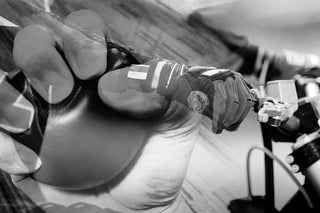Moto PR: Improve Your Move
Hello FTR Family,
We are almost there! At the time of this writing, we are heading into our last hare scramble and enduro of the 2023-2024 season. At the end of the season, we know that season long championship battles can come down to the smallest of factors, and every movement counts. From leaning into turns to executing precise maneuvers, a racer's agility and control are paramount. While much attention is given to your race machine and riding technique, an often-overlooked factor in racing performance lies within the intricate mechanics of the hand. Specifically, the juncture tendinum, or tendon junctures, play a crucial role in how riders manipulate the clutch and front brake, influencing their ability to navigate the track with finesse and speed.
The ED is the primary muscle that extends your fingers. It runs all the way from your elbow to the very tip of your fingers on the back of your hand. Juncturae tendinum are fibrous connections that link the tendons of the extensor digitorum (ED) muscle in the hand. These connections serve as bridges between the tendons, enhancing their stability and facilitating coordinated movement of the fingers. In the context of motorcycle racing, the juncturae tendinum plays a pivotal role in transmitting force from the muscles to the fingers, allowing riders to modulate the clutch and front brake with precision.
Controlling the clutch is essential for managing speed, acceleration, and gear changes during a race. The juncture tendinum contributes to this process by ensur- ing efficient transfer of force from the extensor digitorum muscle to the fingers. As riders engage the clutch lever, the juncture tendinum helps distribute the pressure evenly across the tendons, enabling smooth and respon- sive clutch modulation. The juncturae tendinum can also determine which fingers) you use on those controls.
Once you progress past beginner riding technique, most racers use one to two fingers on the clutch and front brake. For the single finger racers out there have you ever wondered why some people prefer the index finger vs. the middle finger? Oftentimes it is the easier finger to extend based on the tension of your juncturae tendinum (fibrous connections) between each tendon of your ED muscle. Try this experiment: make a closed fist with your left (clutch) hand. Now extend each finger one at a time, and independently of the other fingers. With your right hand, hold all other fingers closed in the fist position. What you might notice is that when you extend a certain finger ti wil not go as far as the others do and when you really try hard to extend it you feel a pulling sensation in your hand. That finger is least likely to be the one you use for clutch control. If this happens to your index or middle finger you will notice you use whichever finger moves the most freely with this exercise or you use both fingers. This way you are working around the limitations of the juncturae tendinum. Personally, it is the reason why Iwould never be able to use my middle finger in isolation to operate the clutch or front brake.
You can switch hands and perform the same isolated finger extension exercise on your right hand to gain insight on the fingers) for front brake usage. Precise application of the front brake can make the difference between a successful maneuver and a potential disaster. Here again, the juncture tendinum plays a critical role. By optimizing the connection between the extensor digitorum muscle and the fingers, these tendon junctures enable riders to apply the front brake with accuracy and consistency. Whether scrubbing of speed before a tight turn or trail braking through a chicane, riders rely on the juncture tendinum to deliver the necessary braking force with confidence.
Maximizing the potential of juncturae tendinum in motorcycle racing requires proper training and conditioning. Riders often incorporate specific exercises targeting hand strength, flexibility, and coordination to optimize the function of these tendon junctures. Grip strengthening exercises, finger dexterity drills, and proprioceptive training can help improve clutch and brake control, allowing riders to harness the full capabilities of their hands on the racetrack.
If you have any questions or comments, please email me at contact@motopt.com, or call/text 904-395-5379. Let's IMPROVE YOUR MOVE so you can ride pain-free with MotoPT. I will see you at the races!
References
Chinchalkar SJ, Barker CA, Owsley B. Relationship Be- tween Juncturae Tendinum and Sagittal Bands. J Hand Microsurg. 2015 Jun;7(1):96-101. doi: 10.1007/12593- 015-0172-8. Epub 2015 Jan 17. PMID: 26078512; PM- CID: PMC4461641.
Dr. Matthew Daugherty
PT, DPT, OTR/L, MOT, DBA Associate Professor
Board-Certified Orthopaedic Clinical Specialist Fellow, American Academy
of Orthopaedic Manual
Physical Therapists Manual Therapy Certified
Dry Needling Certified


